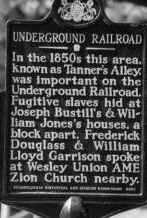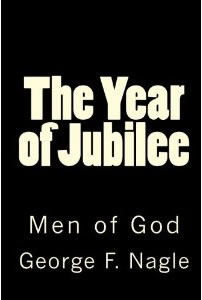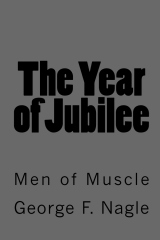
Study Areas
Home of William and Mary Jones Invaded by Slave Catchers
Harrisburg, Pennsylvania, November 1842
The documentation of specific incidents involving Underground Railroad activities, people and places often relies on published reminiscences and accounts recorded in local newspapers or court proceedings. Events involving large scale demonstrations or protests by local residents against the appearance of slave catchers in their town might be reported in local newspapers, particularly if there is a threat or actual display of violence. Less spectacular incidents, even one involving the degree of violence described in the letter below, may or may not merit a mention by local newspaper editors.
The incident recounted below, in which a local constable in support of several Maryland slave catchers along with a mob of white residents smashed the front door of a local African American man suspected of sheltering escaped slaves, was not reported in Harrisburg newspapers. Fortunately, details of the raid were recorded in a letter from a man in Harrisburg and sent to an anti-slavery newspaper in New York City. Thomas W. Brown's letter is important for several reasons. It identifies Harrisburg African American resident William Jones as the target of the mob. The involvement of Jones and his wife Mary in Harrisburg area Underground Railroad activities is already well documented, and this letter adds important substance to other accounts. It verifies that Jones was known, as early as 1842, of hiding freedom seekers in his home at River and Barberry Streets. It occurred during the same time period in which white abolitionist Rudolph Kelker was actively forwarding freedom seekers from his Front Street mansion to a barn that he owned in that same neighborhood, to be received by Jones and his wife.
The letter below should be read with the knowledge that it was written by an abolitionist-minded man who may have obtained the details from secondhand sources or eyewitnesses. While there may be inaccuracies, it's value lies in the identification of Jones, his home, his reputation and the time period.
Text of news article in the National Anti-Slavery Standard (New York, NY), 15 December 1842:
MORE ATTEMPTS AT KIDNAPPING.
HARRISBURG, Dec. 3d, 1842.
Last Thursday morning, four individuals from Maryland arrived here, in search of six slaves, who absconded from said State, and were claimed by them. The reward offered was a great inducement: six hundred dollars -- a hundred a head. A few white persons, who are ever on alert upon such occasions, suspected that a colored man, by the name of William Jones, harbored them. They immediately sounded the alarm, raised a posse, and, in company with the claimants, proceeded to the dwelling of said Jones. Mr. Jones, being aware of their intentions, secured his house; although the slaves were not there; and he positively refused them admittance.
The constable, Mr. Harris, by the advice of a few who wished to be well versed in law, forthwith departed for the squire's office, to procure a search warrant; which on oath of the claimants, was granted by the magistrate; and they again proceeded to the scene of the action. On arriving, he read the warrant to Mr. Jones, who again promptly refused to open his doors. Harris and the slaveholders then desisted, and went to a tavern not far distant, to discuss the propriety of forcing open the door.
While in the tavern, one of the slaveholders offered $10 to any person who would break open said door, whether the slaves were found there, or not. Harris accepted the proffered sum, and rushed to the dwelling, where, by three or four violent blows with an aze, he burst open the door. He stood on the sill of the door, and with a thundering voice invited all the by-standers in.
A sudden rush was made, and in a few moments the lower part of the house was filled. Finding no slaves there, they made an effort to run up stairs; but here again they were debarred, by the locking of another door. Harris again displayed his daring courage. Away went the door! and the posse, as before made another rush up stairs. But lo! no slaves could be found. They then searched the whole house, to no avail.
Meanwhile, Mr. Jones departed and procured a warrant for the arrest of the rioters. He succeeded in arresting Harris, and two of the slaveholders, who entered bail for their appearance in the morning; the court being then in session. At the appointed time they appeared before Judges Blythe and Bucher. Messrs. M'Cormick and Cake were for the defendants, and Messrs. Grimshaw and M'Clure for the plaintiff. The case was ably argued by both parties. The judge, in the absence of positive evidence that a search warrant had been granted, decided in Jones's favor, and held the defendants to bail in the sum of $200; with the exception of Mr. Harris, who was held to ordinary bail for his appearance at the next term.
My pen is inadequate to describe the indignation manifested by the peacable citizens of this lovely borough, at this outrageous attempt by citizens of another State, to trample upon the laws of Pennsylvania. The general opinion is, that the strictest penalties of the law will be enforced and sustained. So much for the Keystone State!
THOMAS W. BROWN.
Notes
Brown's letter to the National Anti-Slavery Standard was dated December 3, 1842, a Saturday. He located the described event as "last Thursday morning," placing it either in the previous week, which would have been November 24, or two days prior, which would have been December 1.
The Harrisburg constable named is George Harris, who was one of three men elected for that office in March of that year. Constables during that time were non-uniformed elected officials who received pay only through collected fees and fines. This George Harris should not be confused with George Washington Harris (1798-1882), son of Robert Harris and grandson of John Harris II, the founder of Harrisburg. George W. Harris was an accomplished lawyer and politician, and as he was serving as a Dauphin County Commissioner that same year, would not also been a mere constable. In addition, George W. Harris was always identified with his middle initial in news items, advertisement and legal notices.
The two judges identified who heard the charges brought by William Jones against Harris and two of the Maryland men were Calvin Blythe, President Judge of the Twelfth Judicial District, and John Conrad Bucher, who was appointed associate judge of Dauphin County from 1839 by Governor Andrew Porter, and who served until his death in 1851.
The Underground Railroad activity of William and Mary Jones is summarized on their Who's Who page, here. William Jones' obituary, with biographical information, may be found here.
Sources
- National Anti-Slavery Standard (New York, NY), 15 December 1842.
- State Capitol Gazette (Harrisburg, PA), 23 March 1842.
- Roger B. Meilton, Esq., "History of the Dauphin County Court of Common Pleas," in Dauphin County Court of Common Pleas, 1785-2015, 2015, p. 34.
- Biographical Directory of the United States Congress, 1831. 12
Now Available on this site
The Year of Jubilee
Vol. 1: Men of God and Vol. 2: Men of Muscle
by George F. Nagle
Both volumes of the Afrolumens book are now available on this website. Click this link to read for free.
The Year of Jubilee is the story of Harrisburg'g free African American community, from the era of colonialism and slavery to hard-won freedom.
 Volume One, Men of God, covers the turbulent beginnings of this community, from Hercules and the first enslaved people, the growth of slavery in central Pennsylvania, the Harrisburg area slave plantations, early escapes by the enslaved, to the birth of a free black community. Men of God is a detailed history of Harrisburg's first black entrepreneurs, the early black
churches, the first black neighborhoods, and the maturing of the social institutions that supported this vibrant community.
Volume One, Men of God, covers the turbulent beginnings of this community, from Hercules and the first enslaved people, the growth of slavery in central Pennsylvania, the Harrisburg area slave plantations, early escapes by the enslaved, to the birth of a free black community. Men of God is a detailed history of Harrisburg's first black entrepreneurs, the early black
churches, the first black neighborhoods, and the maturing of the social institutions that supported this vibrant community.
It includes an extensive examination of state and federal laws governing slave ownership and the recovery of escaped slaves, the growth of the African colonization movement, anti-colonization efforts, anti-slavery, abolitionism and radical abolitionism. It concludes with the complex relationship between Harrisburg's black and white abolitionists, and details the efforts and activities of each group as they worked separately at first, then learned to cooperate in fighting against slavery.
Non-fiction, history. 607 pages, softcover.
 Volume
Two, Men of Muscle takes the story from 1850 and the Fugitive Slave Law of 1850, through the explosive 1850s to the coming of Civil War
to central Pennsylvania. In this volume, Harrisburg's African American community weathers kidnappings, raids, riots, plots, murders, intimidation,
and the coming of war. Caught between hostile Union soldiers and deadly Confederate soldiers, they ultimately had to choose between fleeing
or fighting. This is the story of that choice.
Volume
Two, Men of Muscle takes the story from 1850 and the Fugitive Slave Law of 1850, through the explosive 1850s to the coming of Civil War
to central Pennsylvania. In this volume, Harrisburg's African American community weathers kidnappings, raids, riots, plots, murders, intimidation,
and the coming of war. Caught between hostile Union soldiers and deadly Confederate soldiers, they ultimately had to choose between fleeing
or fighting. This is the story of that choice.
Non-fiction, history. 630 pages, softcover.
Newly republished editions featuring new cover designs may be ordered from Amazon. Click the cover images below for more information.



